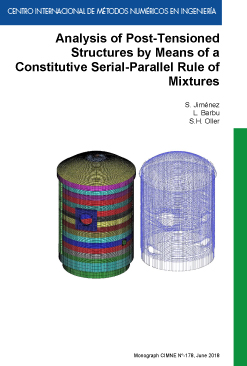Analysis of Post-Tensioned Structures by Means of a Constitutive Serial-Parallel Rule of Mixtures
FREE!
Editorial: CIMNE
Year of publication: 2018
Pages: 143
Editorial: CIMNE
Year of publication: 2018
Pages: 143
Description
The main objective of this thesis is to present a novel methodology for the analysis of post-tensioned concrete structures, based on the potential oered by the use of the Serial-Parallel Rule of Mixtures when modelling composite materials. The advantages of this methodology are studied in comparison to the available approaches, i.e. the formulation proposed by the standards used in the design of structures and the mechanism used in numerical simulation based on the nite element method (FEM).
The Serial-Parallel Rule of Mixtures allows the modelization of each component material in depth, working as a constitutive model manager in order to simulate the composite material being studied. The prestressed concrete is modelled as a composite material with long bres where the bre orientation is dened by the steel tendon direction.
Therefore, the most suitable constitutive model can be used in each case. In the present thesis this is: for the matrix – concrete an isotropic damage model and for the bre – steel a viscoelasticity model, achieving an extraordinary accuracy in the micro-scale. The analysis is based on the FEM, which combined with the Serial-Parallel Rule of Mixtures theory allows the study of large-scale structures, taking into account the specic geometric requirements of the construction.
Three application examples are included which are used for validating the methodology and the potential of this approach. The rst two cases are two isostatic beams that allow the comparison with the results obtained through the study using analytical methods. Finally, the third case shows the results obtained recently
for the analysis of a Benchmark, in which the behaviour of a mock-up of
a reactor containment building has been studied.
Additional information
| Year of Publication | 2018 |
|---|---|
| format | Monograph |

